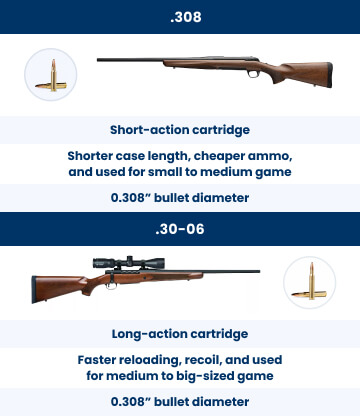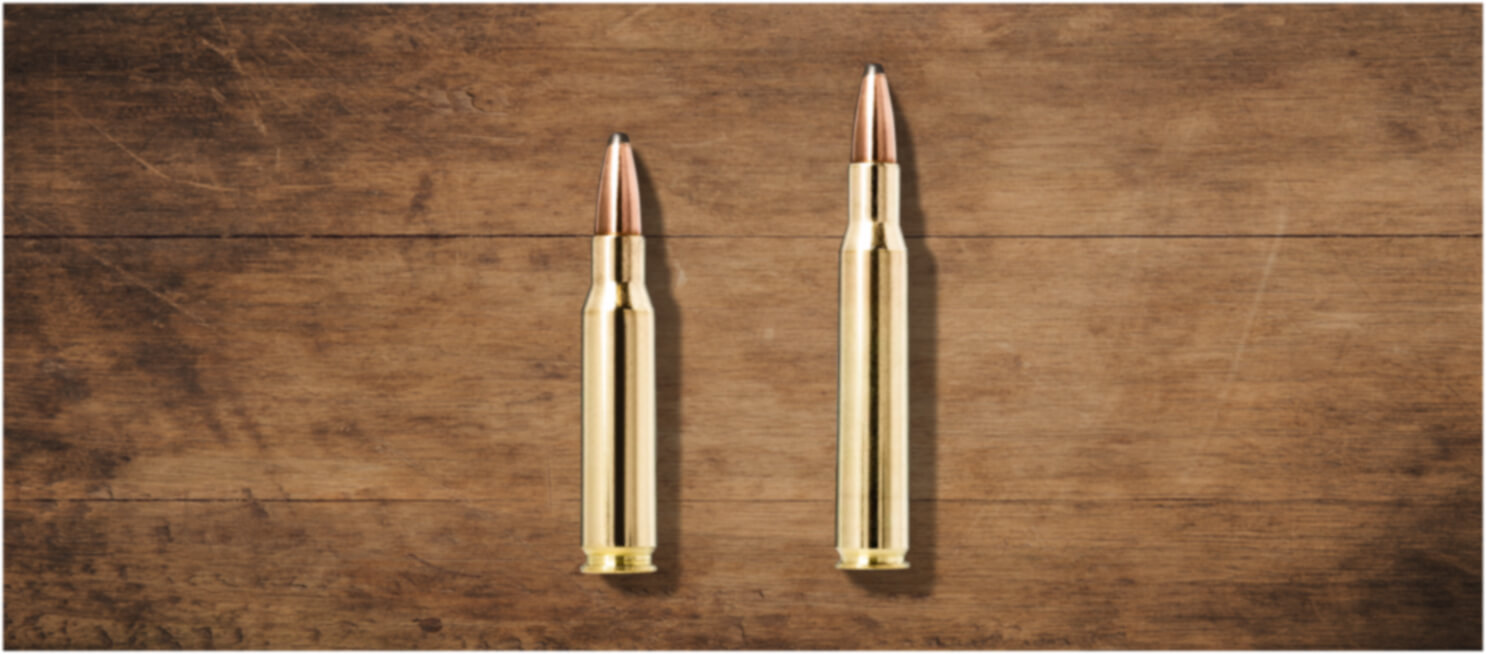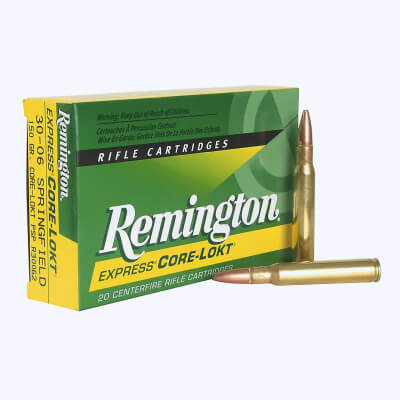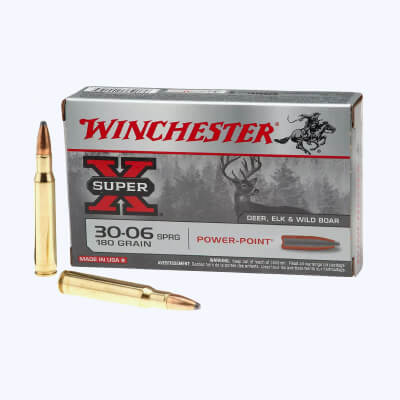.308 vs .30-06: Head to Head

If you're a big game hunter, you're no stranger to the ongoing debate surrounding .308 Winchester vs .30-06 Springfield cartridges. With deep-rooted histories in war and hunting, these two cartridges have assembled a dedicated following, sparking passionate conversations among firearm enthusiasts.
In this guide, you’ll learn about the cartridge's specs, ballistics, firearms, and more. We’ll put emotions aside to determine whether the .308 or .30-06 cartridge reigns supreme.
Key Takeaways
- .308 vs .30-06: Key Specifications: The .308 is a short action cartridge, and the .30-06 is a long action cartridge. They both have a bullet diameter of .308”. The .30-06 has a longer case by about 0.54 inches.
- .308 vs .30-06: Ammo Comparison: The .30-06 features higher muzzle velocity and accuracy at longer ranges. The .308 has less felt recoil and is cheaper per round.
- .308 vs .30-06: Head-to-Head: The .308 has a slightly lower recoil, muzzle energy, and velocity. The longer case of the .30-06 gives it a slightly higher ballistic coefficient and longer trajectory.
.308 vs .30-06: Key Specifications
Both cartridges share a .308-inch bullet diameter, establishing a common ground in their ballistic capabilities. However, a significant distinction lies in their cartridge case lengths. The .30-06 boasts a case length of 2.494 in. The .308 features a 2.015-inch case, setting the stage for differences in performance.
When it comes to velocity and recoil, the .30-06 outpaces the .308. It delivers higher speeds and a more substantial recoil — further setting these cartridges apart. Below, we’ll break down their specs regarding parent casing, max pressure, and more.
| .308 vs .30-06: Key Specifications | ||
|---|---|---|
| Type | .308 Winchester | .30-06 Springfield |
| Parent Case | .300 Savage | .30-03 Springfield |
| Bullet Diameter | 0.308 in (7.82 mm) | 0.308 in (7.82 mm) |
| Neck Diameter | 0.343 in (8.71 mm) | 0.340 in (8.64 mm) |
| Case Length | 2.015 in (51.18 mm) | 2.494 in (63.3 mm) |
| Overall Length | 2.81 in (71.37 mm) | 3.34 in (84.84 mm) |
| Case Capacity | 3.64 ml (56 grains) | 4.42 ml (68 grains) |
| Max Pressure (SAMMI) | 62,000 psi | 62,000 psi |
You can use the following definitions to better understand bullet specifications and the characteristics of different cartridges. These definitions provide essential information for comparing and choosing the right ammunition for your needs.
-
Parent Casing: The original cartridge case from which a new cartridge is derived.
-
Bullet Diameter: The bullet diameter is the diameter of the bullet without its casing.
-
Neck Diameter: The measurement of the cartridge case diameter between the case's body and mouth.
-
Case Length: The measurement of the cartridge case itself, excluding the bullet. It indicates the length of the empty cartridge case.
-
Overall Length: The measurement from the top of the bullet to the bottom of its casing indicates the loaded cartridge's total length.
-
Case Capacity: The volume inside the cartridge case that can hold liquid, typically measured when the bullet is not yet inserted.
-
Max Pressure (SAAMI): SAAMI stands for Sporting Arms and Ammunition Manufacturers' Institute, which sets industry standards for ammunition. Max Pressure (SAAMI) represents the maximum safe pressure levels for ammunition.

.308 vs .30-06: Ammo Comparison
When comparing the .308 and .30-06 cartridges, there are slight differences and unique advantages. The .30-06 offers greater case capacity, making it suitable for reloaders and providing more range and firepower.
In contrast, the .308 is known for accuracy and affordability, making it popular in target shooting. It also has a friendlier recoil and is lighter for hunting trips. Your choice depends on your specific preferences and whether reloading is a factor.

.308 Ammo
The U.S. military developed the .308 Winchester ammunition in the 1950s, and became popular in short-action rifles. It’s ammo averages 2,620 fps muzzle velocity and 2,743 ft-lbs muzzle energy.
- Hunting: The .308 round excels in big game hunting, particularly for elk. It’s also practical for deer hunting.
- Accuracy: The .308 is known for its exceptional accuracy. It benefits from its efficient cartridge design.

.30-06 Ammo
The .30-06 Springfield ammunition first appeared in 1906. It saw extensive use in World War I and is a nostalgic choice. It became widely used in bolt-action sporting rifles and is a top choice for hunting rounds.
- Hunting: Hunters like the .30-06 for hunting deer, elk, and wild boar. This cartridge is excellent for big game hunting.
- Power: The .30-06 is slightly more powerful than the .308, providing more reliable expansion at distances up to 400 yards. This power makes it a preferred choice for long-range shooting.

The Hornady Precision Hunter .308 Winchester Ammunition weighs 178 grains. It offers terminal performance with a muzzle velocity of 2600 fps and can hold 20 rounds. Similarly, the Hornady Precision Hunter .30-06 Springfield weighs 178 grains and can hold 20 rounds. It achieves a slightly higher muzzle velocity of 2750 fps.
.308 vs .30-06: Head-to-Head
Both of these cartridges rank among the best performing in their class, delivering reliability and precision for hunters. Review our table to learn more about the main differences between the .308 and .30-06.
| Uses | Hunting, target shooting, military | Hunting, target shooting, military |
| Ballistics | Reliable with low wind drift | Slightly better due to longer case |
| Velocity | 2,675 ftps (muzzle) 1,871 ftps (300 yards) |
2,700 fps (muzzle) 1,891 fps (300 yards) |
| Recoil | Moderate | Moderate to high |
| Price Per Round | $0.40-$2.50 | $1.20-$2.50 |
| Bullet Drop | Slightly more pronounced | Slightly less pronounced |
| Energy | Lower: 1,986 ft-lb (muzzle) | Higher: 2,023 ft-lb (muzzle) |
| Range | Up to 400 yards, depending on the bullet grain. | Up to 800 yards (or more) depending on the bullet grain. |
Uses
Both the .308 Winchester and .30-06 Springfield cartridges are popular choices for hunting. They cater to different types of game due to their distinct ballistic characteristics.
Ballistics
The ballistic coefficient (BC) of a cartridge or round measures its ability to overcome air resistance while in flight. The BC will be higher if the round is more sleek, narrow, and heavy. A higher BC contributes to increased velocity, meaning a straighter trajectory and less likelihood of wind drift.
-
When it comes to the .308, a round-nosed 180-grain round achieves a BC of .248. A pointed 190-grain .308 round has a BC of .495.
-
In comparison, the .30-06 Springfield 165-grain bullet boasts a BC of .339. While the .308 Winchester and .30-06 Springfield show minimal differences in ballistics, the .30-06 generally offers better energy performance.
Velocity
With a difference in muzzle velocity of only 25 fps, it can be difficult to tell the difference in performance between the .30-06 vs .308. See how they compare when it comes to the size of the game and shooting distance.
-
At a distance of 300 yards, the .308 Winchester shows velocity 20 fps less than the .30-06. This similarity makes it a reliable choice for medium-range hunting.
-
A closer ranges (less than 500 yards) the .30-06 Springfield excels in velocity, which can be helpful when hunting big game. Despite minor differences, this cartridge maintains a slight edge over the .308.
Recoil
In terms of recoil, both the .308 Winchester and .30-06 Springfield fall in the mid-range category. Factors like the use of a suppressor and shooter technique can influence the felt recoil.
-
The .308 Winchester typically produces a lighter felt recoil compared to the .30-06. This lighter recoil can be helpful for beginners or those sensitive to kickback.
-
The .30-06 Springfield generates more recoil than the .308. This increased recoil is a trade-off for its higher power and longer-range capabilities.
Price Per Round
If you want to practice at the range, the .308 Winchester is a more cost-effective option. Both cartridges generally come at a relatively lower price.
-
The .308 Winchester typically ranges in price from $0.40 to $2.50 per round. This price range makes it affordable for regular practice and extensive use.
-
On average, the .30-06 Springfield costs between $1.20 and $2.50 per round. While slightly more expensive than the .308, it remains a reasonably priced option for its capabilities.
Bullet Drop
At a distance of 300 yards, both the .308 Winchester and .30-06 Springfield experience an average bullet drop of around 13 inches. See how they compare at 500 yards.
-
At 300 yards, the .308 Winchester typically sees a bullet drop of about 10-12 inches. Extending the range to 500 yards, the drop increases to approximately 56 inches.
-
For the .30-06 Springfield, the bullet drop at 300 yards is generally around 8-10 inches. At a distance of 500 yards, the bullet drop is about 55.3 inches, nearly identical to the .308.
Energy
Both the .308 Winchester and .30-06 Springfield pack a ton of energy. Below is a comparison of their energy outputs.
-
The .308 delivers approximately 1,900-2,800 ft-lbs of muzzle energy, depending on the grain. This offers substantial power for various shooting applications. Increasing the bullet grain will always increase the energy of the round.
-
The .30-06 produces roughly 2,000-3,300 ft-lbs of muzzle energy, making it a powerful choice for larger game. If you’re new to hunting big game, another option includes the .30-30 Winchester, which averages 1,890 ft-lbs.
Range
The .308 Winchester and .30-06 Springfield have similar effective ranges with lighter bullets. However, the .30-06 gains an advantage when using heavier bullets.
-
The .308 Winchester has an effective range of 300 yards, depending on the grain. You won’t achieve great results if you push it to 400 yards.
-
The .30-06 Springfield can maintain effectiveness at ranges exceeding 1,000 yards for the heaviest grain bullets. Its sweet spot is 800 yards for hunting.
Have Fun Out There!
Ready to plan your next hunting trip? At Academy, we offer a range of .308 Winchester Rifles and .30-06 Springfield Rifles for all of your big game hunting needs. Prepare for hunting or target shooting with our selection of .308 and .30-06 ammunition. Let one of these cartridges take your game to the next level! Big-game hunting season will never be the same again.
 Gift Cards
Gift Cards

